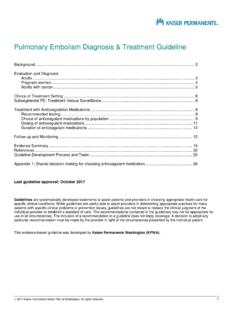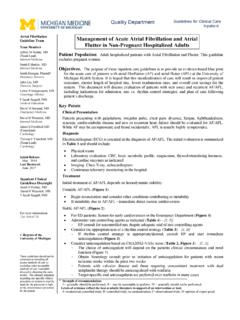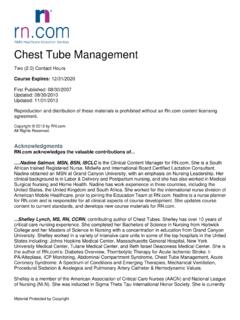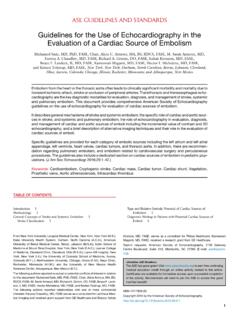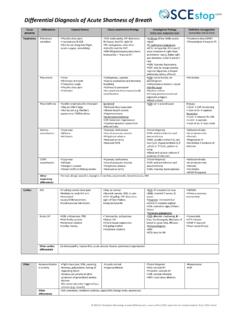Transcription of Thrombolysis Therapy in Pulmonary Embolism UHL Guideline
1 Guideline for Thrombolysis Therapy in Pulmonary Embolism Page 1 of 8 V2 approved by Policy & Guideline Committee on 17 July 2020 (review date extension) Trust ref: B24/2016 (formerly C23/2009) Next Review: January 2021 NB: Paper copies of Guideline may not be most recent version. The definitive version is held in the Policy and Guideline Library on Insite Thrombolysis Therapy in Pulmonary Embolism UHL Guideline Trust ref: B24/2016 1. Introduction / Scope All Patients with Pulmonary Embolism (PE) require rapid risk stratification. This Guideline applies to all health professionals required to undertake a risk / benefit analysis for patients in whom the diagnosis of PE has ideally been confirmed.
2 The adverse effects of thrombolytic Therapy can be devastating and the indications and potential benefits need to be carefully weighed against the risk of adverse effects. 2. Background PE accounts for 10% of patients admitted with non-traumatic sudden death and 50% of those arriving with electromechanical dissociation or asystole on ECG1 Thrombolytic agents activate plasminogen to form plasmin. This results in the accelerated lysis of thrombi. The efficacy, indications, contraindications and adverse effects of thrombolytic Therapy in Pulmonary embolus are summarised below: Thrombolytic Therapy The decision to treat with Thrombolysis should be taken at consultant level.
3 This decision should be based upon the assessed clinical severity and prognosis of the Pulmonary embolus, the bleeding risk and wherever possible after confirmation of the diagnosis by appropriate imaging Before treatment with Thrombolysis , stop heparin. The severity of Pulmonary embolus may be assessed from the following predictor of 30-day mortality after PE, based upon routinely available clinical parameters2 Guideline for Thrombolysis Therapy in Pulmonary Embolism Page 2 of 8 V2 approved by Policy & Guideline Committee on 17 July 2020 (review date extension) Trust ref: B24/2016 (formerly C23/2009) Next Review: January 2021 NB: Paper copies of Guideline may not be most recent version.
4 The definitive version is held in the Policy and Guideline Library on Insite Thrombolytic Therapy - Pulmonary Embolus Efficacy of Thrombolysis Thrombolytic Therapy accelerates clot lysis is associated with short term physiological benefits3-5 HAS NOT BEEN PROVEN TO IMPROVE MORTALITY 7,8 No effect on recurrence of PE7 Indications for Thrombolysis Massive PE acute massive PE is defined by the presence of haemodynamic instability not the physical size of the clot Persistent hypotension (systolic BP less than 90mmHg for 15 minutes) (GRADE 1B evidence)9 UNLESS there are major contraindications owing to the bleeding risk (see below) Submassive PE acute PE without systemic hypotension but with either RV dysfunction or myocardial value of Thrombolysis is uncertain and must be determined on a case by case basis with consultant decision.
5 Consider administration of thrombolytic Therapy in selected high-risk patients without hypotension who are judged to have a low risk of bleeding (Grade 2B evidence).Poor prognostic indicators include the following9: Patients who appear ill, with marked dyspnoea, anxiety and severe hypoxaemia Elevated troponin Right ventricular dysfunction on echocardiography Right ventricular enlargement on CTPA or cardiac echo Other factors to consider are free-floating right ventricular thrombus, extensive thrombus load on CTPA or large perfusion defect, or the patient is known to have a patent foramen ovale Contraindications Absolute History of haemorrhagic stroke Active intracranial neoplasm Recent (less than 2 months)
6 Intracranial surgery or trauma Active or recent internal bleeding n the prior 6 months Relative Bleeding diathesis Uncontrolled severe hypertension (systolic BP greater than Guideline for Thrombolysis Therapy in Pulmonary Embolism Page 3 of 8 V2 approved by Policy & Guideline Committee on 17 July 2020 (review date extension) Trust ref: B24/2016 (formerly C23/2009) Next Review: January 2021 NB: Paper copies of Guideline may not be most recent version. The definitive version is held in the Policy and Guideline Library on Insite Drug Regimen Drug Origin Half Life (mins) Antigenicity Dose by peripheral infusion t-PA- Alteplase preferred option Recombinant 5 No Over 65Kg 10mg iv bolus followed by 90mg iv infusion over 2 hours Under 65kg 10mg iv bolus then max infusion dose should not exceed If cardiac arrest imminent - 50mg bolus Streptokinase (consider no previous administration) Bacterial 20 Yes Allergic reactions, anaphylaxis Asthma Antibody formation Accelerated regimen.)
7 Million units over 2 hours 250,000 unit dose over 30 minutes Urokinase Cell structure 15 No 2000 unit/kg loading dose followed by 2000 unit/kg/hour The 8th ACCP guidelines recommend that thrombolytic treatment be administered via a peripheral vein rather than placing a Pulmonary catheter (grade 1B evidence) and that in patients with acute PE being treated with thrombolytic Therapy regimens with short infusion times (eg a 2hour infusion) are used over those with prolonged infusion times (eg a 24 hour infusion) (grade 1B evidence)9 After treatment with Thrombolysis ,use heparin 18U/kg/hour as a continuous infusion as soon as the APTT is less than twice the upper limit of normal.
8 APTT monitoring is required 6 hourly after any dose change and at least daily. Heparin is continued until warfarin is in the therapeutic range (usually INR 2-3) for at least 2 days. The patient should have a minimum of 5 days of heparin treatment. Catheter-directed Thrombolysis Intrapulmonary infusion 200mmHg or diastolic greater than 110mmHg) Non-haemorrhagic stroke within the prior 2 months Surgery within the previous 10 days Thrombocytopaenia platelets less than 100x109/l Guideline for Thrombolysis Therapy in Pulmonary Embolism Page 4 of 8 V2 approved by Policy & Guideline Committee on 17 July 2020 (review date extension) Trust ref: B24/2016 (formerly C23/2009) Next Review: January 2021 NB: Paper copies of Guideline may not be most recent version.
9 The definitive version is held in the Policy and Guideline Library on Insite There is no evidence that direct infusion of thrombolytics into the Pulmonary artery via a Pulmonary arterial catheter confers greater benefit than peripheral vein infusion. Intraembolic infusion This delivers the thrombolytic directly into the embolus and is associated with increased Thrombolysis in animal models Adverse effects to Thrombolysis Bleeding Bleeding is the most common adverse effect associated with Thrombolysis but there are also some thrombolytic agent specific adverse reactions. Accelerated fibrinolysis is not limited to the symptomatic thrombus but acts on all fibrin deposits.
10 Bleeding occurs most commonly at sites of invasive procedures but there may also be pathological lesions within the brain, gastrointestinal tract or genitourinary tract. Thrombolysis in PE has a reported 3% risk of intracranial haemorrhage12. Fibrinolytic agents have an effect on platelets, fibrinogen and other plasma proteins. Some of these patients may also be on concurrent anticoagulant and antiplatelet agents. Treatment of thrombolytic bleeding If intracranial bleeding is suspected, stop infusion of the thrombolytic agent immediately, obtain imaging, consult neurosurgery and correct haemostasis as below.
